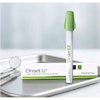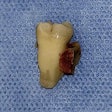
If you haven’t read part one of this two-part article, I suggest reading it now to glean the full scope of its message as it applies to part two.
Comfort for the patient during dental procedures is the goal of dental analgesia/sedation. The popularity of IV conscious sedation in dentistry has risen as has a rise in deaths associated with the administration of conscious sedation.¹
It is imperative that practitioners and their staff undergo training and have guidelines in place to ensure patient safety in the dental office setting. Researching this issue carefully is suggested before IV conscious sedation becomes part of your practice regime. Dentists providing sedation and anesthesia must comply with their state rules and regulations.
Defining different levels of sedation and anesthesia that will accommodate the needs of the specific patients and their treatment plan must be carefully chosen by evaluating each patient's physical (conducting an in-depth review of the patient’s health history findings) and psychological status, the length of the procedure, any contraindications for the drugs to be administered, and the choice of the type of sedative to be used.
In part two of this article, I discuss the billing and coding considerations for IV sedation, not the types of drugs or the names of the agents used.
The goals for using IV sedation/analgesia include the following:
- To calm patients or eliminate their anxiety
- Reduce the gagging reflex
- Increase the patient’s pain threshold and allow for longer chair appointments
- Increase the patient’s cooperation and limit bodily movements
- Pain relief
When creating clinical notes for the patient’s chart, the name(s) of the anesthetic agent(s) used is noted along with the dosage of each agent, the time involved (in increments) in the procedure, and the patient’s reactions and level of comfort. The patient's notes must describe the medical necessity for using IV agents. It’s also important to detail why the dentist’s findings pointed to the need for this type of anesthetic.
When coding for billing and insurance filing, the agent's name and the administration route are unnecessary for filing the claim. The current Code on Dental Procedures and Nomenclature (CDT) codes relating to IV anesthesia (CDT 2024 from the ADA) are as follows:
- D9215 -- Local anesthesia in conjunction with operative or surgical procedures
- D9219 -- Evaluation for moderate sedation, deep sedation, or general anesthesia*
The level of anesthesia is determined by the anesthesia’s provider documentation of the anesthetic effects on the central nervous system and is not dependent on the route of administration.
As defined by the ADA:²
Moderate sedation is a drug-induced depression of consciousness during which patients respond purposefully to verbal commands either alone or with light tactile stimulation. Spontaneous ventilation is adequate. Cardiovascular function is usually maintained.
Minimal sedation is a minimally depressed level of consciousness that retains the patient's ability to independently and continuously maintain an airway and respond normally to tactile stimulation and verbal command. Ventilatory and cardiovascular functions are unaffected.
Deep sedation is a drug-induced depression of conscience during which the patient cannot be easily aroused by responding purposefully following repeated or painful stimulation. The ability to independently maintain ventilatory function may be impaired. The patient may require assistance in maintaining a patent airway. Cardiovascular function is usually maintained.
General anesthesia is a drug-induced loss of consciousness during which patients are not arousable. The ability to maintain ventilatory function is often impaired. Cardiovascular function may be impaired.2
There are four CDT codes that can be used. These codes include:
- D9222 -- Deep sedation/general anesthesia - first 15 minutes
- D9223 -- Deep sedation/general anesthesia - each subsequent 15-minute increment
- D9239 -- Intravenous moderate (conscious) sedation/analgesia - first 15 minutes
- D9243 -- Intravenous moderate (conscious) sedation/analgesia - each subsequent 15-minute increment
These codes are reported in 15-minute increments. The anesthesia time begins when the doctor administering the anesthetic agent initiates the appropriate anesthesia and noninvasive monitoring protocol and remains in continuous attendance of the patient. The time ends when the patient may be safely left under the observation of trained personnel and the doctor may safely leave the room.³
D9248 -- Nonintravenous conscious sedation is the code used for non-IV minimal and moderate sedation. The clinical procedure notes documented on the patient’s chart must support the coding descriptor and nomenclature choice.³
*There are four CDT drug codes -- D9610, D9612, D9613, and D9630 -- that reference the use of therapeutic medications but are not used in reporting the administration of sedative, anesthetic, or reversal agents.4
References
- Mason KP, Robak MG, Chrisp D, et al. Results from the adverse event sedation reporting tool: A global anthology of 7952 Records Derived from >160,000 procedural sedation encounters. J Clin Med. 2019; 8(12): 2087.
- CDT 2023 Current Dental Terminology. 1st ed. Chicago, IL: American Dental Association; 2023:290.
- Guidelines for the Use of Sedation and General Anesthesia by Dentists. American Dental Association. https://www.ada.org/-/media/project/ada-organization/ada/ada-org/files/publications/cdt/anesthesia_guidelines.pdf.
- CDT 2024 Current Dental Terminology. 1st ed. Chicago, IL: American Dental Association; 2024:82.
Estela Vargas, CRDH, is the founder and CEO of Remote Sourcing, a dental insurance billing and revenue recovery service. She is a graduate of Miami Dade College's dental hygiene program. Vargas' extensive background in the clinical arena of dentistry is coupled with her experience as a practice administrator and business executive.
The comments and observations expressed herein do not necessarily reflect the opinions of DrBicuspid.com, nor should they be construed as an endorsement or admonishment of any particular idea, vendor, or organization.



















